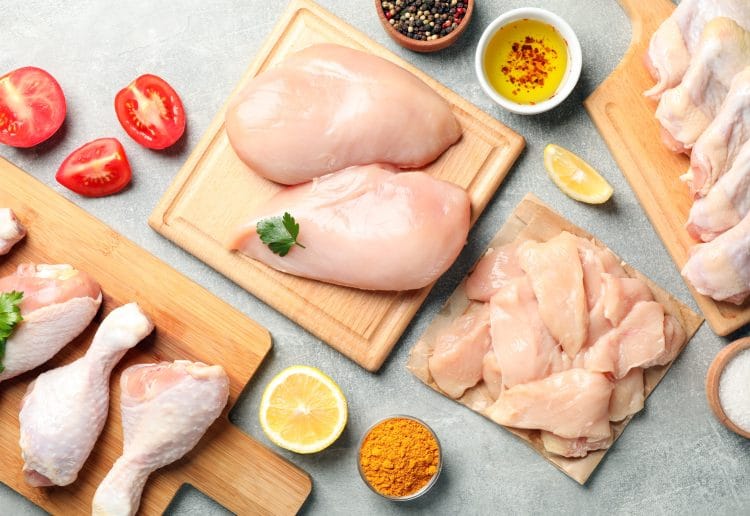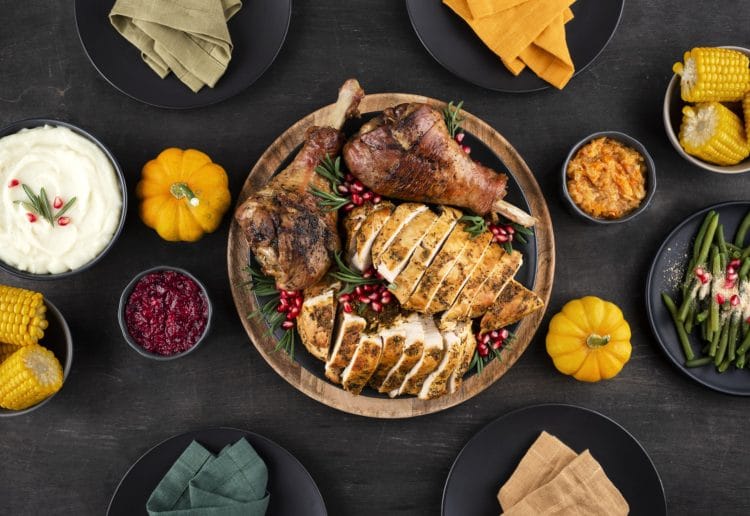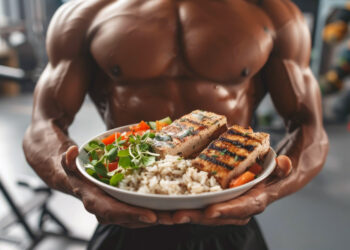Whether you want to build muscle or burn fat, consuming enough protein is vital to your success. That’s why protein powders are such popular supplements, and many exercisers drink protein shakes before or after training. This insight comes from Patrick Dale, a seasoned fitness expert with decades in the industry, and is reviewed by Ash, an ACE-certified personal trainer with a master’s degree in Exercise Science.
The amount of protein you need depends on your goals, activity levels, and body weight. Intense exercise causes the catabolic breakdown of muscle tissue, necessitating more than the RDA of protein (1). Most exercisers need closer to two grams per kilo of body weight for muscle repair and growth.
Protein also plays an important role in fat burning and weight loss. It has a high thermic effect and is very filling leading to an increase in total daily energy expenditure. You can determine your protein requirements more accurately by using our online protein calculator.
There are lots of foods you can eat to get the protein you need, both animal and plant-based. Some of the best high-protein foods are listed here.
Two of the most popular protein foods are chicken and turkey. While both of these foods come from the same nutritional group – poultry – they are different enough that one may be more beneficial than the other.
In this article, we compare turkey against chicken, analyzing which might better align with your health and training goals, backed by our expert team’s knowledge and experience.
Level Up Your Fitness: Join our 💪 strong community in Fitness Volt Newsletter. Get daily inspiration, expert-backed workouts, nutrition tips, the latest in strength sports, and the support you need to reach your goals. Subscribe for free!
Turkey vs. Chicken – Calories
If you want to manage your weight, calories matter. To gain weight, you need a calorie surplus. But, if you’re going to lose weight, you need a calorie deficit. Getting to grips with your caloric intake invariably means analyzing and tracking your food intake, but this step is necessary if you want to make the best possible progress.
Turkey and chicken contain differing amounts of calories, so you may want to choose one or the other depending on your body composition goals. In general, for the same cut of meat, turkey is usually lower in calories than chicken (2).
Calories in Chicken and Turkey
| Calorie values for raw and cooked cuts of chicken and turkey | |
| Item | Calories |
| Whole chicken with skin, raw | 171 |
| Whole chicken with skin, roasted | 200 |
| Whole chicken skinless, raw | 110 |
| Whole chicken skinless, roasted | 160 |
| Chicken, wing skinless, raw | 193 |
| Chicken, wing with skin, raw | 196 |
| Chicken, wing with skin, roasted | 283 |
| Chicken, drumstick with skin, raw | 125 |
| Chicken, drumstick with skin, roasted | 201 |
| Chicken, drumstick skinless, raw | 107 |
| Chicken, drumstick skinless, roasted | 175 |
| Chicken breast, raw | 100 |
| Chicken breast, roasted | 129 |
| Whole turkey with skin, raw | 135 |
| Whole turkey skinless, raw | 109 |
| Turkey rump, raw | 107 |
| Turkey rump, roasted | 131 |
| Turkey drumstick with skin, raw | 126 |
| Turkey drumstick with skin, roasted | 191 |
| Turkey drumstick skinless, raw | 113 |
| Turkey drumstick skinless, roasted | 190 |
So, if weight loss is your goal, turkey is arguably your best choice. However, the number of calories in the meat depends on the cut and cooking method used.
Turkey vs. Chicken – Fat
The main reason that turkey and chicken contain differing amounts of calories is their fat content. Turkey, which is often viewed as a drier meat, typically has less fat than a similar cut of chicken (2).
| Fat values for raw and cooked cuts of chicken and turkey | |||||
| Items | Total | Sat | Mono | Poly | Chol (mg) |
| Whole chicken with skin, raw | 10.6 | 3.27 | 4.12 | 2.29 | 93 |
| Whole chicken with skin, roasted | 10.2 | 3.04 | 2.91 | 2.66 | 119 |
| Whole chicken skinless, raw | 3.6 | 1.23 | 1.08 | 0.81 | 75 |
| Whole chicken skinless, roasted | 5.4 | 1.72 | 1.38 | 1.51 | 109 |
| Chicken, wing skinless, raw | 12.4 | 4.24 | 3.72 | 2.79 | 89 |
| Chicken, wing with skin, raw | 14.3 | 4.41 | 5.56 | 3.09 | 82 |
| Chicken, wing with skin, roasted | 17.4 | 5.46 | 6.45 | 3.84 | 91 |
| Chicken, drumstick with skin, raw | 5.7 | 1.61 | 1.61 | 1.58 | 94 |
| Chicken, drumstick with skin, roasted | 8.5 | 2.53 | 2.43 | 2.22 | 91 |
| Chicken, drumstick skinless, raw | 3.7 | 1.08 | 1.06 | 0.98 | 88 |
| Chicken, drumstick skinless, roasted | 6.2 | 1.98 | 1.58 | 1.73 | 109 |
| Chicken breast, raw | 0.8 | 0.25 | 0.19 | 0.23 | 60 |
| Chicken breast, roasted | 0.9 | 0.29 | 0.23 | 0.25 | 75 |
| Whole turkey with skin, raw | 6.9 | 2.22 | 1.66 | 2.96 | 195 |
| Whole turkey skinless, raw | 2.4 | 0.90 | 0.62 | 0.60 | 63 |
| Turkey rump, raw | 1.2 | 0.38 | 0.31 | 0.34 | 50 |
| Turkey rump, roasted | 1.4 | 0.43 | 0.37 | 0.38 | 62 |
| Turkey drumstick with skin, raw | 6.0 | 1.91 | 1.81 | 1.70 | 73 |
| Turkey drumstick with skin, roasted | 9.3 | 2.80 | 2.67 | 2.71 | 110 |
| Turkey drumstick skinless, raw | 4.6 | 1.72 | 1.18 | 1.15 | 67 |
| Turkey drumstick skinless, roasted | 8.7 | 2.84 | 2.41 | 2.48 | 107 |
Sat = saturated fat
Mono = monounsaturated fat
Poly = polyunsaturated fat
Chol = cholesterol
So, if you want to consume less fat, either for weight loss or health purposes, turkey is usually the best option. However, there are also differences between the various cuts, and removing the skin also lowers the fat content.
How you cook your poultry can also affect how much fat is in it, i.e., grilling or steaming vs. frying. That said, both turkey and chicken are generally lower in fat than most types of red meat. i.e., beef, pork, and lamb. This makes them both good choices for weight loss and health.
Turkey vs. Chicken – Protein
Turkey and chicken are good sources of complete protein. A complete protein contains all nine of the essential amino acids. When supplied with the essential amino acids, your body can synthesis the remaining 11 non-essential amino acids.
Your body uses the amino acids in protein like a builder uses bricks. They are the raw material for muscle repair and growth. Broadly speaking, turkey contains a little more protein than chicken, but the actual protein content depends on the cut of meat in question.
| Protein values for raw and cooked cuts of chicken and turkey | |
| Items | Protein (g) |
| Whole chicken with skin, raw | 19.0 |
| Whole chicken with skin, roasted | 27.1 |
| Whole chicken skinless, raw | 19.4 |
| Whole chicken skinless, roasted | 27.9 |
| Chicken, wing skinless, raw | 20.3 |
| Chicken, wing with skin, raw | 16.7 |
| Chicken, wing with skin, roasted | 31.7 |
| Chicken, drumstick with skin, raw | 18.4 |
| Chicken, drumstick with skin, roasted | 31.2 |
| Chicken, drumstick skinless, raw | 18.5 |
| Chicken, drumstick skinless, roasted | 29.9 |
| Chicken breast, raw | 23.3 |
| Chicken breast, roasted | 30.2 |
| Whole turkey with skin, raw | 18.2 |
| Whole turkey skinless, raw | 21.9 |
| Turkey rump, raw | 24.0 |
| Turkey rump, roasted | 29.6 |
| Turkey drumstick with skin, raw | 17.9 |
| Turkey drumstick with skin, roasted | 26.7 |
| Turkey drumstick skinless, raw | 18.0 |
| Turkey drumstick skinless, roasted | 28.0 |
Turkey could be a slightly better choice for bodybuilding purposes than chicken because it contains more protein per gram. However, the differences in protein content are actually pretty small, and most people should be able to consume enough protein whether they eat chicken or turkey.
Turkey vs. Chicken – Vitamins and Minerals
Despite differing values in calories, protein, and fat, there is very little variation in vitamin and mineral content between turkey and chicken. However, there are some nutrient differences between white and dark meat.
In general, light breast meat contains more niacin and vitamin B6 than darker leg meat, while chicken leg meat contains significantly more zinc than breast meat (2).
So, if you’re looking to increase your zinc intake, dark meat may be a better option. In contrast, you want to consume more vitamin B, white meat could be preferable.
That said, when it comes to most vitamins and minerals, the best sources are invariably plant-based food. Vegetables, fruits, and grains are usually much more vitamin and mineral-rich than most types of meat. Eating a wide variety of foods is generally the best way to get all the nutrients you need.
Wrapping Up
In the battle between turkey vs. chicken, there is no undisputable winner. Both types of poultry are nutritionally similar, can be healthy, and help you reach your fitness goals.
Turkey is usually a little higher in protein and lower in fat and calories than chicken, but the differences are quite minor. Despite this, if you are trying to lose weight, these small advantages may be worth considering.
That said, there are nutritional differences between cuts and cooking methods that you should also consider. You could easily turn your low-calorie turkey into a cause of weight gain by frying it and adding a whole lot of extra fat. In contrast, removing the skin from turkey or chicken makes it lower in fat and calories.
Ultimately, most people can benefit from eating turkey AND chicken. Eating both will add variety to your diet and help you get a broader range of nutrients. It’s rarely a good idea to limit your intake to just a couple of foods, as doing so could leave you deficient in certain nutrients, and your meals will soon become boring.
References:
1 – Harvard Medical School: How Much Protein Do You Need Every Day? https://www.health.harvard.edu/blog/how-much-protein-do-you-need-every-day-201506188096
2 – PubMed: Role of Poultry Meat in A Balanced Diet Aimed at Maintaining Health and Wellbeing https://www.ncbi.nlm.nih.gov/pmc/articles/PMC4462824/











